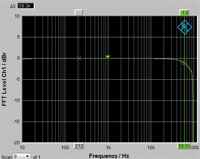Page 6 of 6
MEASURED PERFORMANCE Dynamic range is a crucial metric for DACs and – worldwide – there are only two DAC manufacturers, ESS of the USA and Chord Electronics of the UK, conspicuously ahead in the game. Where the best DACs today can manage 119dB or so, ESS DACs start at 122dB and reach 133dB. Chord Electronics reply with Dave, that managed a massive 129dB under measurement – ahead of most else. Its unusually high dynamic range value is a clear indicator of its advanced nature. This value was obtained at +3dB on the volume control, which avoids output overload occurring with a full level (0dB) digital signal, and was via AES/EBU balanced digital input and the balanced analogue XLR output. The unbalanced phono-socket output, that is usually derived from the balanced line, was just -1.5dB worse, with digital input via optical. Dave’s designer, Rob Watts, insists distortion is more important than dynamic range (which sums distortion and noise). In this area Dave was all but distortion free with 24bit, measuring 0.0015% our analysis shows, at -60dB – lower than all else. With CD it was 0.21%, the usual figure that is a measure of 16bit quantisation noise, not convertor linearity. So Dave has less distortion than all other DACs. Output from XLR was a massive 12V, and from the unbalanced phono sockets 6V – 3x higher than usual. The headphone socket gave 6V output, more than enough for any headphone. The volume control of Dave is unusual in controlling level early in the signal chain. Turning it up too far will cause overload on musical peaks, but it also improves effective dynamic range. Chord have given it a 0dB safety value that avoids overload, but measurement showed +3dB can be used – and this setting was used for all measurements. Far more gain is available – up to +19dB, but overload is likely to become obvious, except when playing very low level recordings. Frequency response measured flat to 55kHz (-1dB) with a 192kHz sample rate signal, our analysis shows, filter out. With the filter in output starts to fall above 22kHz, again with a 192kHz sample rate signal. So the filter will barely be audible in effect, serving to reduce supersonics and likely improve impulse response. With CD the filter has little effect. The optical inputs will not accept sample rates above 96kHz, falling silent with any higher input, so Astell&Kern players will not work with Dave when playing 176.4k or 192k files – disappointing in such an expensive item. The USB input worked up to 768kHz sample rate with Mac’s El Capitan operating system (OSX-10.11.3) and dynamic range via USB was also 129dB, so Dave is not noisy through USB. Measurement showed Dave is one of the world’s most advanced DACs. A low 96kHz sample rate limit via optical is the only limitation. NK
FREQUENCY RESPONSE
DISTORTION
|
Search
Hi-Fi World, Powered by Joomla!; Hosted by Joomla Wired.








